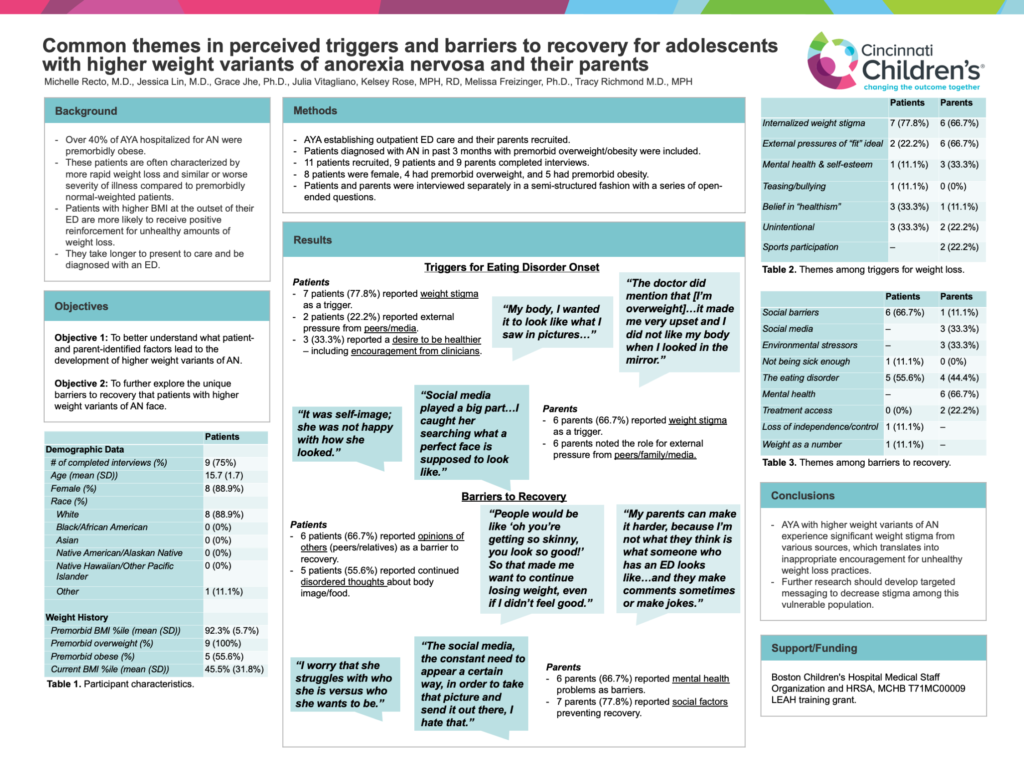Common themes in perceived triggers and barriers to recovery for adolescents with higher weight variants of anorexia nervosa and their parents
Michelle Recto, M.D., Jessica Lin, M.D., Grace Jhe, Ph.D., Julia Vitagliano, Kelsey Rose, MPH, RD, Melissa Freizinger, Ph.D., Tracy Richmond M.D., MPH

In a study investigating patient and parent perspectives on triggers for disease onset and barriers to recovery for patients with higher weight variants of anorexia nervosa, a majority of respondents identified significant weight stigma from peers, family, social media, and clinicians as an inappropriate pressure to initiate and maintain unhealthy weight loss.
Michelle Recto, MD
Abstract
Background: Over 40% of adolescents hospitalized for anorexia nervosa (AN) have premorbid BMIs classified as overweight/obese, often losing weight more rapidly and presenting with similar or worse severity of illness when compared to their premorbidly normal-weighted counterparts.
Objective: To understand what triggers lead to higher weight variants of AN.
Methods: We interviewed adolescents establishing outpatient AN care and their parents about weight loss triggers. Patients diagnosed with AN in the past 3 months who had premorbid overweight/obesity were included. Eleven patients were recruited; 9 patients (mean age 15.7 [1.7] years) and 9 parents completed interviews. Eight patients were female, 4 had premorbid overweight, and 5 had premorbid obesity.
Results: When asked, “What changed the way you ate, exercised, or thought about your body?” 7 patients (77.8%) reported internalized weight stigma. One patient said “I thought I was overweight. When I wasn’t progressing, I got frustrated with myself” while another noted, “I was scared that if I’m not losing weight, then I’m gonna gain weight.” Conversely, 2 patients (22.2%) reported external pressure from peers or social media, noting “I wanted to look like what I saw in pictures” and “I saw how my friends were skinnier.” Additionally, 3 patients reported weight loss to be “healthier,” recalling encounters with clinicians that affected body image—one noted “The doctor mentioned [I’m overweight]…it made me upset and I did not like my body in the mirror” and another said “the doctor wasn’t trying to be mean…but ‘oh God other people think it too!’” Six parents (66.7%) reported internalized weight stigma as a trigger, noting “It was self-image; she was not happy with how she looked.” Six parents (66.7%) also noted external pressures from family, peers, and social media, noting “Social media played a big part…she was searching what a perfect face is supposed to look like” and “Some people know how to really take a swipe at your self-esteem.”
Conclusions: Adolescents with higher weight variants of AN may experience weight stigma, pressuring them into unhealthy weight loss. Further research should define what “healthy” means and how to decrease stigma and promote positive body image in this vulnerable population.